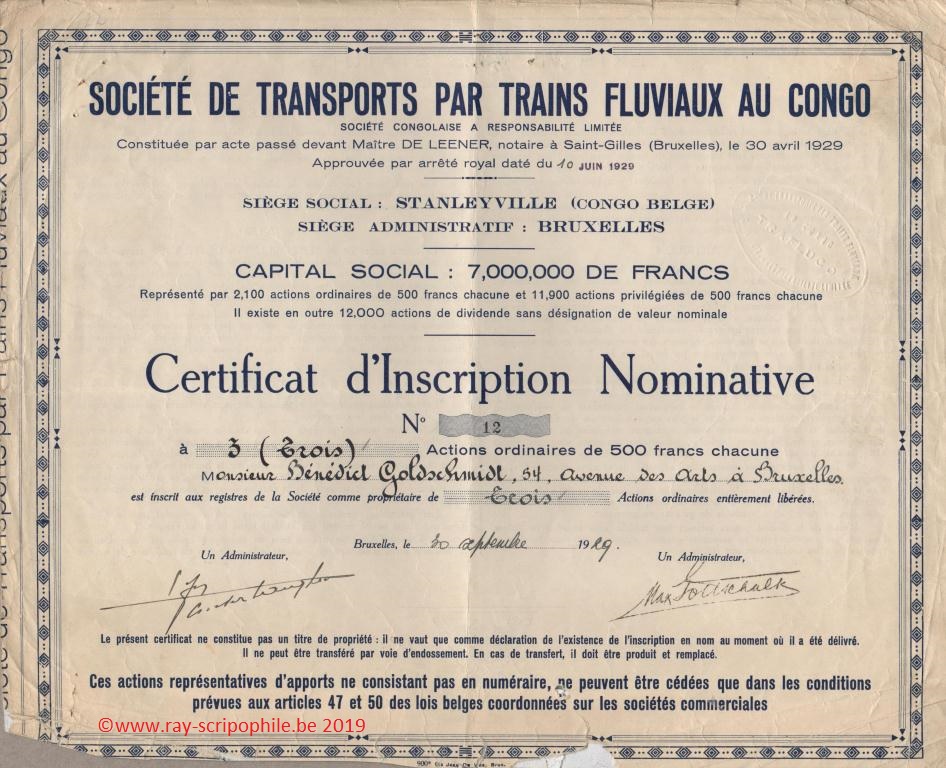SOCIETE DE TRANSPORTS PAR TRAINS FLUVIAUX AU CONGO S.C.R.L.
Constitution
On April 30, 1929, Société de Transports par Trains Fluviaux au Congo, abbreviated to "Trafluco", was formed with a capital of 7 million francs represented by 2,100 ordinary shares of 500 francs and 11,900 preference shares of 500 francs; in addition, 12,000 dividend shares without designation of value were created. The registered office was established in Stanleyville and the administrative headquarters in Brussels.
Of the 2,100 ordinary shares and 11,900 preferred shares, 1,920 ordinary shares and 10,880 preferred shares were subscribed for cash by: table
The subscribed shares were paid up by 30% and a sum of 1,920,000 francs was made available to the new company.
Contribution(s)
Banque Cassel et Compagnie, Banque Henri Lambert, Banque de Bruxelles, Banque Nagelmackers Fils et Compagnie, Dr Léon Bertrand, Compagnie des Chemins de Fer du Congo Supérieur aux Grands Lacs Africains, Mr Louis De Walsche, Mr Robert Goldschmidt, Dr. Antoine Hamesse, General Adolphe de Meulemeester, Société Coloniale de Construction, Société commerciale et Minière du Congo, Société des Chemins de Fer Vicinaux au Congo, Société des Mines d'Or de Kilo Moto, Société Minière de la Télé, S. A. Intertropical Comfina, Société Minière de l'Aruwimi-Ituri, Union Nationale des Transports Fluviaux, M. Pamphile Van Battel, the Belgian Congo Colony, Comptoir Colonial Belgika, Société Commerciale d'Outremer, Syndicat des Transports Economiques au Congo (S. T.E.C.), the Crédit Colonial et Commercial, Mr. Bénédict Goldschmidt, Mr. Max Gottschalck, the Société Cotonnière du Nepoko, the Société Indépendante de Construction et d'Exploitation Radio-Electrique S.I.C.E.R., Mr. Joseph-François Vanderhaeghen, Mr. Auguste Adam;
Have declared to transfer and transport to the new Company all the assets and liabilities of the Joint Venture Association created on February 11, 1927 under the name of Syndicat des Transports par Trains Fluviaux au Congo, between the said named parties with a view to carrying out studies on the use of amphibious river trains in the Belgian Congo, first and foremost on the Aruwimi River, including in particular: a sum of 450. 000 francs, placed by the above-mentioned persons at the disposal of the syndicate and invested by the latter for the achievement of the syndicate's purpose, on condition that the syndicate pays 250,000 francs, with interest at 7.50% from the December 1, 1928 at the first request of the entitled person.
All contributions, studies, plans, negotiations, contracts, preparatory work for development, constructions, buildings of any kind, as well as all documents generally of any kind relating to accounting, material and equipment acquired, contracts, rights and obligations relating to the employment of personnel employed by the said Union; the rights, benefits, advantages, obligations and charges of any kind, resulting or to result from the agreement concluded on January 26, 1929 between the colony of the Belgian Congo and the Société des Chemins de Fer Vicinaux au Congo, acting in the name and on behalf of the Union.
The Société Syndicat des Transports Economiques au Congo (S.T.E.C.), a participant of the Syndicat des Transports Fluviaux au Congo, also contributed the patents registered for their application in the Congo basin, the Matadi-Leopoldville section.
In remuneration of the above contributions, the following titles were attributed to the contributors: table
Throughout the company's existence, during a capital increase by issuing shares to be subscribed for in cash, subscription will be offered by preference to the holders of certificates allocated to the comparators, founders of the company.
First Board of Directors
The number of directors for the first time was set at twelve:
Objet
The purpose of the company was: for itself, on behalf of third parties, either by itself or through third parties, individuals, or companies, either jointly or in participation or in any other form:
The object could always be modified, without however altering its essence, by a decision taken at an extraordinary general meeting in the forms required for amendments to the articles of association (12-(22-06-1929)-10319).
Event(s)
The topographers explored the banks, cleared temporary passages, and continued to survey the land in preparation for the route being laid out. A logging operation was organized north of Yambuya, where teams of sawyers prepared all the timber needed for the work, including the monorail's running rails. This logging center would be linked to the Yambuya logging sites by a 4-kilometre Decauville road currently under construction.
The constructive study of the amphibious equipment had been actively pursued; consultation with the builders had resulted in final agreements.
A reduction in the work program was granted by the Minister of the Colonies following the economic situation (21-(1931 T1)-774/775) Unfortunately, following the economic crisis, Trafluco's activity was suspended "UNATRA report 1931" (21-(1933 T1)-80).
Dissolution and liquidation
The EGM of November 8, 1934 decided to dissolve and liquidate the Company; two liquidators were appointed (12-(23/11/1934)-14502).


